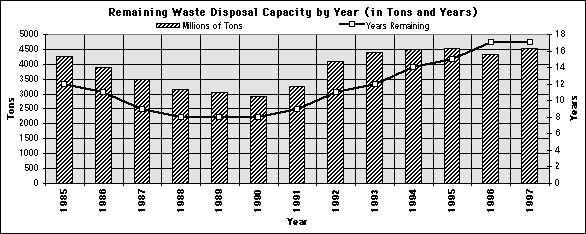Sweeping Debris Disposal

Sweeping Debris Disposal |
 |
What Can We Expect for Future Landfill Fees and Space?by Barbara HudsonJames Thompson, Jr. is president of Chartwell Information, Inc., one of the first companies in the country to actually collect and publish empirical data about waste disposal and projected needs. In 1991, his company discovered that, rather than running out of landfill space, the United States had enough working landfills for over 18 years at projected capacity, more than enough to handle expected waste. 
In Thompson's opinion, the perceived crisis in landfill space during the 1980's was a manufactured scare. "Many different constituencies were ready to embrace the idea that we were running out of landfill space. This was one of the few areas in which the big solid waste companies and the environmentalists actually agreed," Thompson explained. What the 'perceived crisis' allowed, according to Thompson, was for solid waste companies to go ahead and build more landfills to meet the public's need while Congress jumped onto the bandwagon and passed legislation to regulate waste disposal. The Resource Conservation Recovery Act (RECRA) was originally passed in the 1970's, and reauthorized in the mid-80's. RECRA's purpose was to develop regulations for landfills: They had to be lined, have leachate collection systems, ground water monitoring, etc. Similar regulations were developed for incinerators. "The legislation increased the costs of operating these facilities quite a bit and gave an advantage to larger facilities over smaller ones," Thompson outlined. "This changed the whole economic scale of the industry and caused the first big wave of consolidations." So what do the numbers project about landfill space and the cost of dumping waste in the future? "What I see happening over the near term," Thompson said, "is that prices are going to stay pretty flat for waste disposal. That's because there's still a lot of capacity and competition." But waste management companies will continue to grow, he predicts. "They are either buying assets or swapping assets to gain majority control of particular markets." For example, United Waste Systems just agreed to merge with USA Waste. They are going into areas like Springfield, Massachusetts, and either buying out their competition, or outbidding them to force them to merge before they go out of business. This happens in markets where the really big players - for example BFI and Waste Management, Inc. - are absent, creating regional monopolies. Once that happens they can raise prices, of course, but only enough to increase their profits without drawing the attention of other large companies who might jump in and compete. Thompson thinks tipping fees may increase somewhat in the next two to five years, but not significantly. "I'd say you might expect a dollar a year increase, unless you are in an area that uses more rail for hauling. Rail hauling should have a depreciating effect on tipping fees," Thompson explained, "because transportation is an increasingly large component of waste disposal costs, and rail hauling is usually cheaper than trucking." According to Chartwell projections, most of the U.S. has available landfill capacity for the next 18 years if no new facilities or expansions are built (see graph). Since it takes approximately 10 years to go through the permitting process to open a new landfill, any capacity just over this 10 year mark is ideal because it meets disposal needs while avoiding a shortage and subsequent panic. As a result, Thompson foresees slow increases in the cost of tipping fees, and adequate future landfill capacity - good news for the sweeper industry. 
For more information on Chartwell Information, you may contact them at (703) 519-3630. James Thompson, Jr. may also be reached via email sent to jimpson@ibm.net, and the company website is www.wasteinfo.com. This article is reprinted from American Sweeper magazine, Volume 6 Number 2. |
© 2005 - 2019 World Sweeper
|
Sweeping Disposal Contents
|